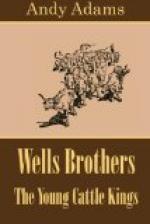Left to themselves, the trio resolved itself into a ways and means committee. “I soldiered four years,” said Priest to the boys, once the sunshade was reached, “and there’s nothing that puts spirit and courage into the firing line like knowing that the reserves are strong. It’s going to be no easy task to hold these cattle this winter, and now is the time to bring up the ammunition and provision the camp. The army can’t march unless the mules are in condition, and you must be well mounted to handle cattle. Ample provision for your saddle stock is the first requirement.”
“We’re putting up a ton of hay a day,” said Joel, “and we’ll have two hundred shocks of fodder.”
“That’s all right for rough forage, but you must have corn for your saddle stock,” urged the man. “Without grain for the mounts, cavalry is useless. I think the railroad supplies, to settlers along its line, coal, lumber, wire, and other staples at cost. I’ll make inquiry to-morrow and let you know when we return. One hundred bushels of corn would make the forage reserves ample for the winter.”
“We’ve got money enough to buy it,” admitted Joel. “I didn’t want to take it, but Mr. Quince said it would come in handy.”
“That covers the question of forage, then,” said Priest. “Now comes the question of corrals and branding.”
“Going to brand the calves?” impulsively inquired Dell, jumping at conclusions.
“The calves need not be branded before next spring,” replied the practical man, “but the herd must be branded this fall. If a blizzard struck the cattle on the open, they would drift twenty miles during a night. These through Texas cattle have been known to drift five hundred miles during the first winter. You must guard against a winter drift, and the only way is to hold your cattle under herd. If you boys let these cattle out of your hand, away from your control, they’ll drift south to the Indian reservations and be lost. You must hold them in spite of storms, and you will need a big, roomy inclosure in which to corral the herd at night.”
“There’s the corn field,” suggested Dell.
“It has no shelter,” objected Priest. “Your corral must protect against the north and west winds.”
“The big bend’s the place,” said Joel. “The creek makes a perfect horseshoe, with bluff banks almost twenty feet high on the north and northwest. One hundred yards of fencing would inclose five acres. Our cows used to shelter there. It’s only a mile above the house.”
“What’s the soil, and how about water?” inquired the gray-haired foreman, arising.
“It’s a sand-bar, with a ripple and two long pools in the circle of the creek,” promptly replied Joel.
“Bring in the horses,” said Priest, looking at his watch; “I’ll have time to look it over before leaving.”
While awaiting the horses, the practical cowman outlined to Joel certain alterations to the corral at the stable, which admitted of the addition of a branding chute. “You must cut and haul the necessary posts and timber before my return, and when we pass north, my outfit will build you a chute and brand your cattle the same day. Have the materials on the ground, and I’ll bring any needful hardware from the railroad.”




